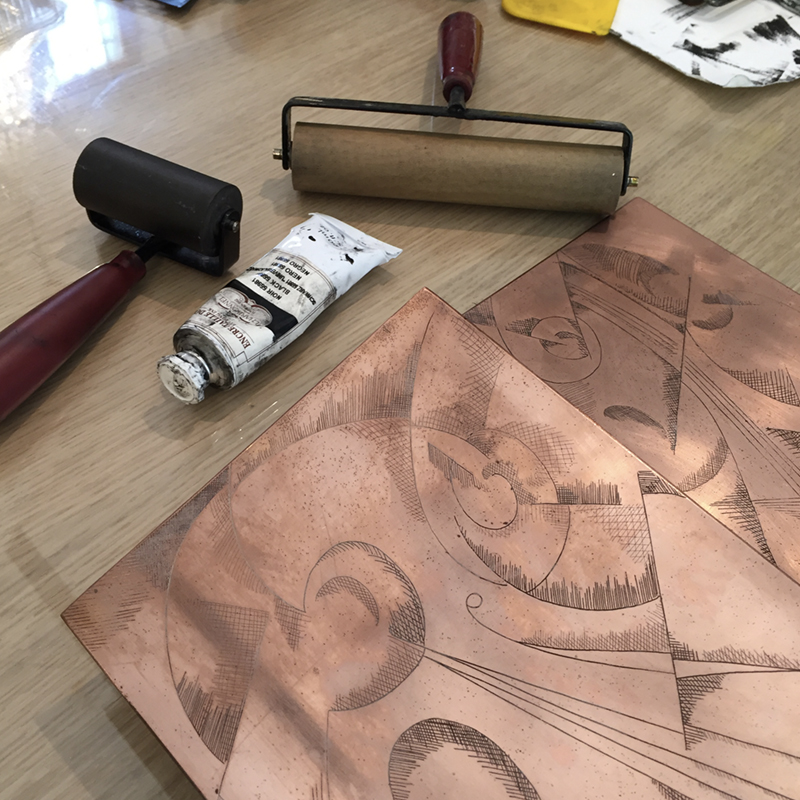Adding text to artwork
If you can't write backwards, adding text to your artwork might be a daunting task. However, there is a simple way to add a nice quote or some text to your artwork:
If working with direct tracing monotypes, you can try the following:- Use a printer and some carbon paper:
First, print your letters or quote in reverse (most printers have this feature) or make a mirror image of your text using phothoshop, and print it.
Place a sheet of carbon paper between this print and the paper you will use for your final project. (Do not wet the paper at this stage).
Trace all the text.
Now that you have the reversed text transferred onto your paper, you are ready to use the direct transfer monotype method to create your image, which can be done by wetting the paper or leaving the paper as is. - If you are not using a printer and need to reverse your text or calligraphy, you can write directly onto thin tissue paper. Then simply flip the paper around and place it on top of carbon paper for tracing onto the back of the paper to be used for your final project.
After transferring text onto good paper, you are ready to use the direct transfer monotype method to create your text/image, which can be done either on wet or dry paper.

Tips for using transfer paper
When using carbon paper, you need to use the right amount of pressure; if you press too lightly, the image won't transfer very well, and if you press too hard, you may damage your working area (i.e. your inked or waxed plate).
If you're not sure whether you're pressing too hard or too soft, carefully lift up a corner of the reference image/photocopy and transfer paper to see what's going on underneath. Just lift up a tiny part without moving the image around or you will lose alignment. When you have finished, inspect the tracing by lifting each corner without moving the image too much. If you see missing parts, it is the right time to go over them.
TRANSFERRING IMAGES ONTO A PLATE TO BE ETCHED
You can buy
white carbon papers available cheaply online, which are great for transferring an image onto a waxed plate.
All you need to do is write your text and reverse it by drawing on the back of the paper which you have placed onto a window - the carbon paper is now placed between the mirrored design and the waxed plate. Be careful not to apply too much pressure. Trace the entire text or image making sure not to forget any parts.
William Blake's Method
How did William Blake manage to write backwards and then apply his prose to a copper plate?
The first thing to keep in mind is that Blake's etchings were relief etchings, that is to say the lettering was raised on the plate (background etched away) and inked up with (presumably) a roller. The best hypothesis (raised by Stanley Hayter) was that he drew the lettering with bitumen (or similar) in the normal (right-reading) manner onto a specially prepared sheet which was then transfered (offset) to the plate with heat and slight pressure. This resulted in the acid-resistant letters adhering to the plate in reverse form. He lastly deep-etched the plate in an acid bath to a sufficient depth to allow the text to be relief-inked.
AMAZON BOOK William Blake's Illustrations for Dante's Divine Comedy: A Study of the Engravings, Pencil Sketches and Watercolors
George Barker tried this, and it worked OK:
- stretched a piece of paper over a board as for watercolours
- coated the dried paper with a mixture of gum acacia and egg-white.
- wrote text (right way 'round) over the dried coating using bitumen and a fine brush. (You can use an old-fashioned pen nib if you wish)
- heated the plate gently and placed it on the press bed.
- placed the paper (removed from board) face down on the plate
- added some newspapers to top of paper (to avoid possible burns on blankets and give a firmer pressure.
- ran through the press under medium pressure
- soaked plate and paper in water until gum/egg-white dissolved and paper floated off the plate.
